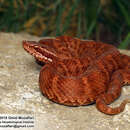- Common names: Siberian pit viper,[2] Halys viper,[3] Halys pit viper,[4] more.
Gloydius halys is a venomous pitviper species found within a wide range that stretches across Asia, from Russia, east of the Urals, eastwards through China. Five subspecies are currently recognized, including the nominotypical form described here.[5]
Description
Gloydius halys grows to a maximum total length of 59 cm (23 in), which was for a female, with an included tail length of 68 mm (2.7 in). The largest male on record measured 53 cm (21 in) in total length, which included a tail length of 80 mm (3.1 in). The body build is described as moderately stout with a snout that is slightly upturned when viewed from the side.[2]
Dorsally, G. halys is grayish, pale brown, reddish, or yellowish, with large dark spots or crossbars, the borders of which are serrated. One or two lateral series of smaller dark spots are present. There is a wide dark stripe behind the eye, bordered by light stripes both above and below. The venter is whitish, speckled with gray or brown.
The strongly keeled dorsal scales are arranged in 23 rows at midbody. The ventrals number 149-174. The anal plate is entire. The subcaudals number 31-44, and are divided (paired).[6]
Common names
Common names for G. halys include Siberian pit viper,[2] Halys viper,[3] Halys pit viper, Pallas's pit viper, Asiatic pit viper, Asiatic moccasin,[4] shchitomordnik,[7] Pallas's viper, Pallas pit viper, Korean pit viper, Mongolian pit viper.[8]
Geographic range
Gloydius halys is found in Russia, east of the Ural Mountains through Siberia, Iran, Mongolia to northern and central China, as well as the southern Ryukyu Islands of Japan. According to Gloyd and Conant (1990), the type locality given is "Salt Lake near the Lugaskoi Sawod (factory) on the Upper Yenisey" (Siberia, Russia). Redefined by Bour (1993) as "Naryn or Ryn Peski desert, near the Russia-Kazakhstan border".[1]
Subspecies
Subspecies
[5] Taxon author
[5] Common name
[9] Geographic range
[1] G. h. boehmei Nilson, 1983
Boehme's pitviper
[10] Known only from the
type locality: Andarab valley,
province of Baghlan, at 2,500 m altitude, eastern
Afghanistan.
[9] G. h. caraganus (Eichwald, 1831) Karaganda pitviper From southeastern Europe, in the
Ural and
Emba River valleys, and (at least formerly) in the
Volga River valley, through much of
Kazakhstan, including northern
Turkmenistan,
Uzbekistan,
Tajikistan and
Kyrgyzstan, into northwestern China.
[2] G. h. cognatus (
Gloyd, 1977) Alashan pitviper North-central China, from eastern
Qinghai across southern
Gansu, probably also in
Qinghai, and possibly eastwards into
Hebei and northwards into
Inner Mongolia.
[9] G. h. halys (
Pallas, 1776) Siberian pitviper Southern Siberia and Mongolia, from the
Zeya River west to longitude 74° E.
[2] G. h. mogoi Bour, 1993 Western
Mongolia.
[9] Etymology
The subspecific name, boehmei, is in honor of German herpetologist Wolfgang Böhme.[11]
References
-
^ a b c McDiarmid RW, Campbell JA, Touré T (1999). Snake Species of the World: A Taxonomic and Geographic Reference, vol. 1. Washington: District of Columbia: Herpetologists' League. 511 pp. ISBN 1-893777-00-6 (series). ISBN 1-893777-01-4 (volume).
-
^ a b c d e Gloyd HK, Conant R (1990). Snakes of the Agkistrodon Complex: A Monographic Review. Society for the Study of Amphibians and Reptiles. 614 pp. 52 plates. LCCN 89-50342. ISBN 0-916984-20-6.
-
^ a b Gotch AF (1986). Reptiles – Their Latin Names Explained. Poole, UK: Blandford Press. 176 pp. ISBN 0-7137-1704-1.
-
^ a b Steward JW (1971). The Snakes of Europe. Cranbury, New Jersey: Associated University Press (Fairleigh Dickinson University Press). 238 pp. LCCCN 77-163307. ISBN 0-8386-1023-4.
-
^ a b c "Gloydius halys ". Integrated Taxonomic Information System. Retrieved 24 May 2007.
-
^ Boulenger GA (1896). Catalogue of the Snakes in the British Museum (Natural History). Volume III., Containing the ... Viperidæ. London: Trustees of the British Museum (Natural History). xiv + 727 pp. + Plates I-XXV. (Ancistrodon halys, pp. 524–525).
-
^ Brown JH (1973). Toxicology and Pharmacology of Venoms from Poisonous Snakes. Springfield, Illinois: Charles C. Thomas. 184 pp. LCCCN 73-229. ISBN 0-398-02808-7.
-
^ U.S. Navy (1991). Poisonous Snakes of the World. New York: U.S. Government / Dover Publications Inc. 203 pp. ISBN 0-486-26629-X.
-
^ a b c d Gumprecht A, Tillack F, Orlov NL, Captain A, Ryabov S (2004). Asian Pitvipers. First Edition. Berlin: Geitje Books. 368 pp. ISBN 3-937975-00-4.
-
^ Beolens, Bo; Watkins, Michael; Grayson, Michael (2011). The Eponym Dictionary of Reptiles. Baltimore: Johns Hopkins University Press. xiii + 296 pp. ISBN 978-1-4214-0135-5. (Gloydius halys boehmei, p.30).
-
^ Beolens B, Watkins M, Grayson M (2011). The Eponym Dictionary of Reptiles. Baltimore: Johns Hopkins University Press. xiii + 296 pp. ISBN 978-1-4214-0135-5. (Gloydius halys boehmei, p. 30).

